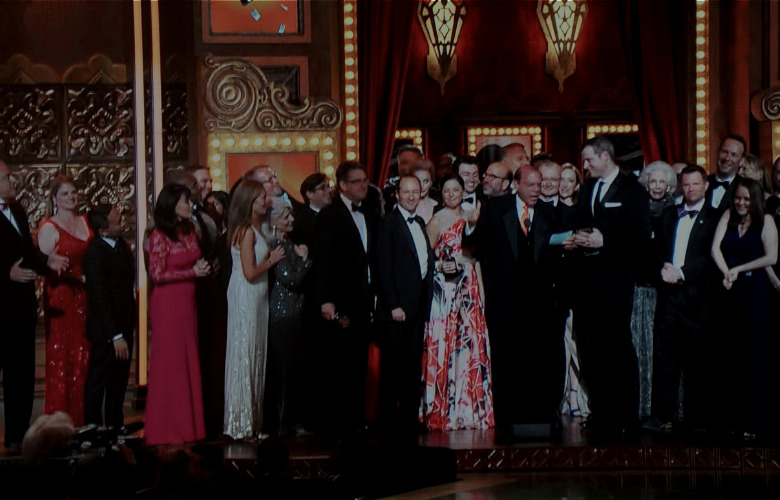
For the past ten years on average, there were 26 producer names above the title on the Tony Award for Best New Musical. Some of the names were for a group or business entity with more than one person. This deluge of producer names became infamous in 2006 with Spring Awakening and an article mocking the lead producers for their “849 producers” (there were actually 27 producers.) With dozens of people holding titles that imply leadership positions, who is in charge? What are they doing? And does it really take 26 people?
Let’s start with the types of producing credits that can appear above the title for a Broadway show. These producers can be a lead producer, co-producer, executive producer, or in association with. There may be associate producers credited on Broadway musicals but these are usually found below the title. The above title credits may be notated with the type of producer or as one long list of names. Above the title show credits indicate that the people or entities are eligible for awards that the show is eligible for. If the show wins a Tony Award and 40 people appear above the show’s title, those 40 people will win a Tony Award. Credits do not just indicate award eligibility but more importantly who have limited liability and who have full responsibility and financial liability.
The exception to this is if the lead producer is transferring a show from another theater as in the case of West End productions to Broadway or large regional theaters or non-profit theaters like A.R.T., The Public Theater, or LaJolla. In these cases, a large part of development costs could be covered in the pre-Broadway production. These bigger theatrical productions are considered proven products that are moving onto a Broadway stage under the guidance of professionals in the Broadway arena.
The budgets of a Broadway show costing millions of dollars include hundreds of line items and these costs can be part of only one phase or crossover from one to the next.
The producer’s involvement in the development can happen in several different ways. The producer could commission a composer, lyricist, and book writing team to create a musical, or the producer could find a show that is fully or partially developed at a regional theater or other organization and obtain the rights and move the show from a smaller theater to a Broadway theater. The development phase includes presenting the show to theater owners, gatekeepers, and other producers or investors to join the producing team. Development includes budgeting, raising the funds, securing the director, and key creative designers and cast. Marketing, timelines, strategy for re-coupment and profit fall into the development phase. The many costs that are associated with getting an idea or script from the page to the stage can be development costs. Once the show is headed to a Broadway theater and starts rehearsals the costs and phase move from development to the running of the show costs.
The lead producer is responsible for the running costs of the production. Broadway is entirely unionized. There are 13 unions on Broadway in COBUG (Coalition of Broadway Unions and Guilds) These unions have thoughtfully negotiated with The Broadway League on behalf of the producers to arrive at the union rates for their members. These union rates are fixed costs and included in the budgets for the musical. Union labor and talent guarantees a certain professional and elevated level of quality. Running costs also include rent to the theater, marketing, accounting, and other costs while the show is selling tickets to performances.
The closing costs are the lead producer’s financial responsibility.The closing costs are the expenses of shutting down a show and moving it out of the theater. Closing costs may include the re-purposing or transferring of the Broadway show’s assets such as set pieces or costumes to the touring company. It can cover any outstanding costs incurred during the run of the show. Understanding when is the correct time to stop selling tickets and announce the last performances is the lead producer’s responsibility. Theaters’ owners can also enforce stop clauses, as in the recent case of Beetlejuice, to remove shows from the theater. How and when cast, creatives, and crew are told can be dictated by the agreements with the unions. This policy ensures that the cast and all people involved in the show do not hear about the show closing from news outlets first.
A lead producer may receive money from fees, royalties, and reimbursement for their office expenses, staff, etc. The co-producers will not receive royalty or fees but will share in the profits. An executive producer is hired early in the process and usually collects a salary or fee immediately. Producers with “in association” credits will receive monies after re-coupment.
We have covered some general expenses and responsibilities of the lead producer. The lead producers are usually the first three or four names in the credits above the title of the show. The other names listed are the co-producers. The co-producers have agreements with the lead producer to raise the financing for the show. The commitment to raise funds gives the co-producer access to certain perks, the biggest is usually the credit above the title and therefore the eligibility for a Tony Award. This credit and eligibility are what separates an investor from a co-producer. The co-producer is only liable for the amount of money that they are contracted for in the agreement. If a show is budgeted at $20 million dollars and the co-producer commits to $1 million dollars if it goes over this budget, the co-producer is still only liable for the $1 million but the lead producer is liable for the overage. There have been cases of co-producers committing to raise funds and failing, this shortage falls back onto the responsibility of the lead producer.
Executive producers are another title that can be found above the title on a Broadway show.
The executive producers can be helpful in raising money but are not liable for the funds and usually start receiving payments as soon as they engage with the lead producer.
Sometimes industry insiders can be dismissive of the groups of people involved in a show. These criticisms involve labeling co-producers as glorified investors or executive producers as elevated general managers. Critics aside, it is important to pick the right team. In addition to raising the capital, they can be very helpful in bringing a different skill set or perspective. The lead producer will set the parameters for the co-producers’ involvement in the show. This should be laid out in the agreement from the beginning with the credits, opening night tickets, access to house seats, an invitation to the first rehearsal, previews, etc. The opinions of the co-producer will be given to the lead producer at marketing meetings or other intersections of the director, designers, actors, press, theater staff, etc, and can be filtered, edited, or dismissed by the lead producer. The input of the co-producers can be additive in their financial contributions, their advice, and their outreach promoting the show.
This could be a regional theater that commissioned, produced, or presented the show before it arrived on the Broadway stage. It could be an individual or group that donated to a regional non-profit organization in the development of the show. It could be a person that introduced the lead producer to a financing source. It is a credit recognizing a contribution or enhancement and acknowledgment that the credited entity may be the recipient of proceeds from the show.
Broadway shows, especially musicals which are traditionally the most expensive to produce, are high-risk investments. The US Securities and Exchange Commission recently updated and expanded their definition of a qualified investor which may make it easier to find financing but there is still so much uncertainty of when audiences will return to theaters and at what price. The responsibilities of producers and the financial liability will likely remain the same when Broadway reopens. But does it really take 26 producers to put up a Broadway musical? The Tony-winning Best Musical for 2019, Hadestown, had 49 producers listed above the title. With the uncertainty ahead in the reopening of Broadway, 26 producers on stage to accept their Tony Awards might look like an intimate group.
Making Broadway Accessible to Audiences with Digital Capture
COVID Creations and Derivatives: Is it Theater?


Bonnie Comley is a three-time Tony Award-winning producer. She has won an Olivier Award and two Drama Desk Awards for her stage productions. She is a member of The Broadway League and serves on their Audience Engagement and Education Committee. Comley has produced over 40 films, winning four Telly Awards and one W3 Award. She is the founder and CEO of BroadwayHD, the world’s premier online streaming platform delivering over 300 premium live productions to theatre fans globally. The theatre community has honored Comley for her philanthropic work; she is the recipient of The Actors Fund Medal of Honor, The Drama League Special Contribution to the Theater Award, The Paul Newman Award from Arts Horizons and The Theater Museum Distinguished Service Award. Comley’s educational honors include The Distinguished Alumni Award from Emerson College and The Distinguished Alumni Award from the University of Massachusetts and the business honor society Beta Gamma Sigma. The Music Theatre Program at Boston University is named in her honor, The Musical Theatre Society Room at Emerson College bears her name, the 500-seat theater at the University of Massachusetts Lowell is known as the Comley-Lane Theatre, and The Stewart F. Lane and Bonnie Comley Stage is housed withi the Booth Arts Complex in Boston. Comley has been a keynote speaker or panelist at BroadwayCon, C2E2 (Chicago ComicCon), SXSW, Theatre Resources Unlimited (TRU), Crain’s New York Arts and Culture Webcast and City National Bank Women Entrepreneurs, and taught masterclasses or guest lectured at Columbia University, New York University, Emerson College, NYFA, Five Towns College and UMass, among others.
Read Full Profile© 2021 TheatreArtLife. All rights reserved.

Thank you so much for reading, but you have now reached your free article limit for this month.
Our contributors are currently writing more articles for you to enjoy.
To keep reading, all you have to do is become a subscriber and then you can read unlimited articles anytime.
Your investment will help us continue to ignite connections across the globe in live entertainment and build this community for industry professionals.